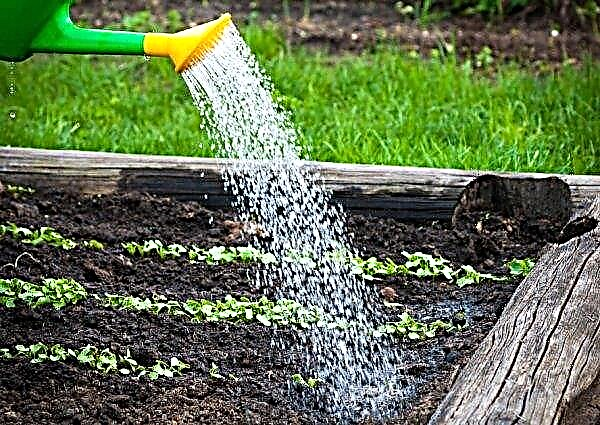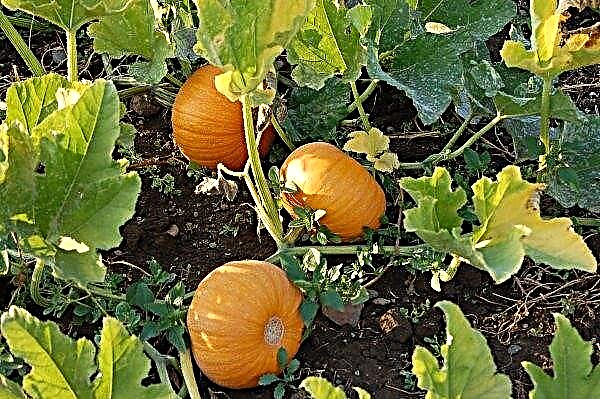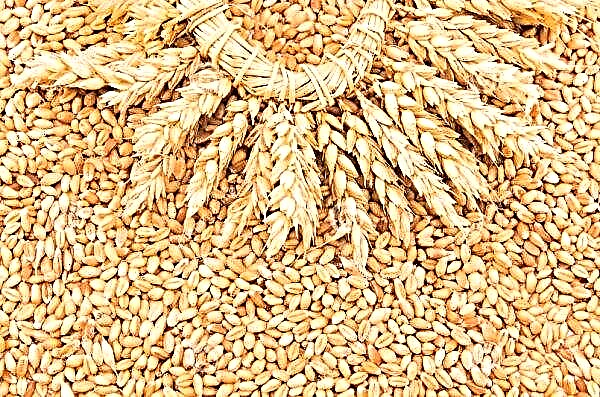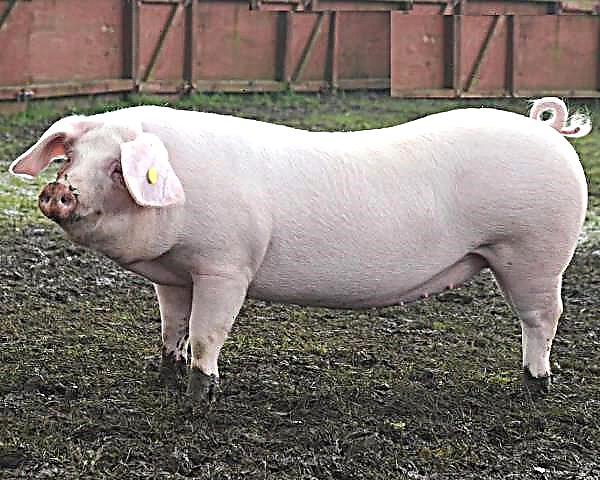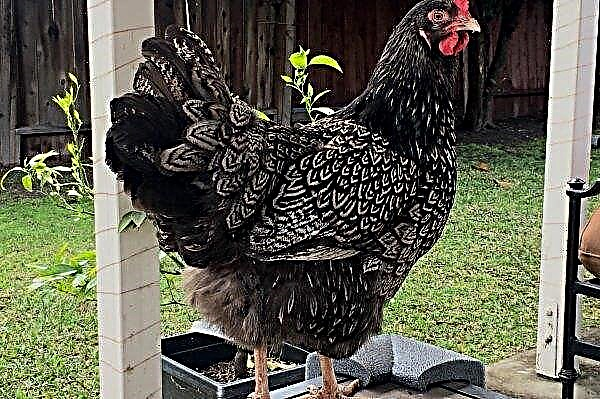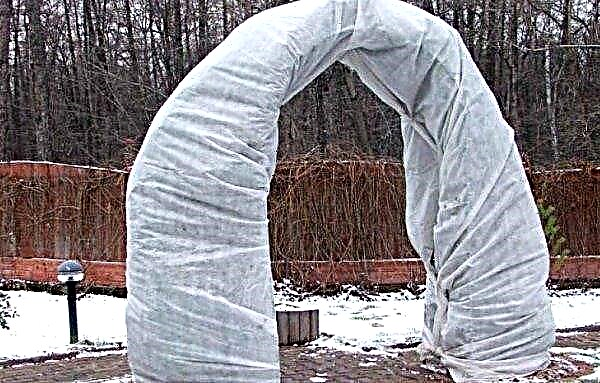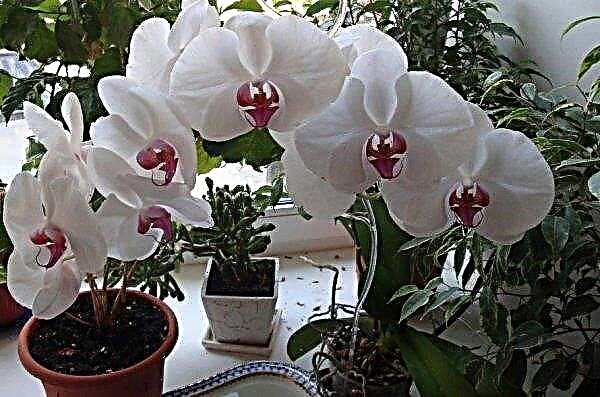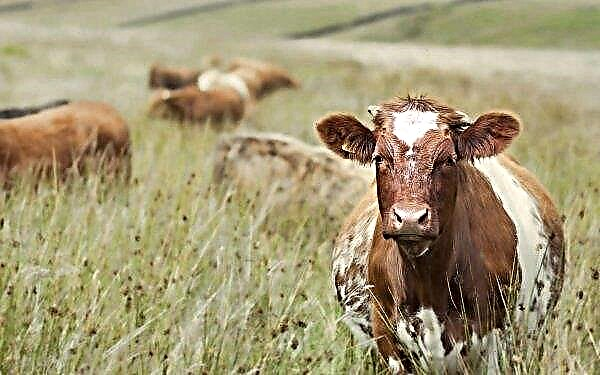Gooseberry cultivation does not cause difficulties: the culture is self-fertile and grows in one place for more than 20 years. The abundance of varieties of sweet and healthy berries is replenished with new hybrid plants, which are even more unpretentious. One of them is gooseberry Green rain, which we will talk about in this article.
Selection history
According to the information about the variety, Rodnik was one of the parent plants, from which the green rain inherited most of the varietal characters. The author of the hybrid gooseberry is Popova Irina Vasilievna, an employee of the FSBIU VSTI gardening. Speaking about the timing of the appearance of the hybrid, they call 2007.
Did you know? Even at the time of Peter I in the Mediterranean countries nothing was known about gooseberries. The Italian ambassadors who visited Russia were surprised to see the berry, and dubbed it with northern grapes.
Description
Srednerosly and srednerskidisty bush is formed by strong shoots. The internodes of the branches are shortened. There are thorns on upright shoots, but they do not interfere with the harvest, since they are located mainly in the lower part of the stem. In addition, the spines are not long and rarely planted. The foliage of the plant is small, delicate, bright green in color, on long pubescent petioles.

At the end of May, the bush blooms in small, single, greenish hues. Fruits appear in late July. The berries are large, weighing an average of 8 g, an elongated oval shape. Bright green fruits are covered with a thin translucent skin, through which all veins of pulp are clearly visible.
With a sufficient amount of sun during ripening, the green gooseberry acquires an amber color. Berries that taste sweet have a delicate aroma and a honey aftertaste.
Advantages and disadvantages
- The popularity of the new variety is due to its advantages:
- resistance to the main diseases (anthracnose, sferotek);
- high productivity;
- large and sweet berries;
- minimal care;
- the versatility of berries.
According to the reviews of experienced gardeners, there were no significant flaws in the Green Rain.
Drought resistance, frost resistance
In the midland and central region, gooseberries can winter without shelter. He endures winter and unexpected thaws in the winter. The plant also tolerates drought calmly thanks to its deep root system.
Productivity and fruiting
Green rain is a quick crop, unlike many varieties, it begins to bear fruit already in the 2nd year after planting.  The fruiting period is the end of July, and the yield from the bush is up to 5 kg. The variety does not need to be planted next to pollinating plants, being self-fertile.
The fruiting period is the end of July, and the yield from the bush is up to 5 kg. The variety does not need to be planted next to pollinating plants, being self-fertile.
Landing
The further development of gooseberries depends on the conditions of planting and crop rotation. The best predecessors for it are root crops and legumes.
The timing
Landing can be carried out in the spring, when there is no threat of return frosts. But if the soil is too wet, it is better to transfer the procedure to autumn. The plant, planted in late September, already at the end of autumn will already grow the root system and calmly winter.
Did you know? Already in 1852, in the monograph of Professor Pansner L.I., about 1000 varieties of gooseberry were described.
Choosing the right place
Landing site choose flat, on a slope or elevated. In the lowlands, melt and rainwater accumulate, cold air stagnates, which is harmful to the plant. Choosing a place, take into account its closedness from the north winds and the depth of groundwater (2 m from the surface). In order for the berries to pick up enough sweetness when ripe, the bushes should be illuminated by the sun for most of the day.

Gooseberries develop well in loose, fertile soil with neutral acidity or in slightly acidic soil. Site preparation consists in cleaning plant residues, deoxidation with lime or dolomite flour if necessary. If the ground is too dense, add sand.
Selection and preparation of planting material
Seedlings of breeding plants are best purchased in nurseries or proven private farms. The material should have developed roots about 25 cm in length. Seedling age - up to 2 years. Before planting, remove the dry parts and soak the roots in sodium humate (3 tbsp. L / 5 l of water).

Landing pattern
Before planting, green holes are prepared for the Green Rain in advance so that the soil has settled in them. For 3 weeks, they dig a hole 50 × 50 cm in size, and the soil extracted from it is divided into equal 2 parts.
One of them is mixed with fertilizers:
- 4-7 kg of humus (the amount depends on the condition of the soil);
- 40 g of potassium sulfate;
- 50 g of superphosphate;
- 2 kg of sand (in clay soil).
If the plant is not planted in a single copy, an interval of 0.8 m is observed between the bushes, 1.5 m between the rows.
Step-by-step landing:
- The fertilized part of the soil is placed on the bottom of the hole with a hill.
- A seedling is placed on a hill; root processes are spread along its slopes.
- Sprinkling with the remaining soil, it is compacted: there should not be voids.
- The growth point of the bush is 5 cm deep.
- After conducting watering, spending about 10 liters of water.
- The trunk circle is mulched, and shoots above the ground are shortened, leaving 5-6 buds.

Features of seasonal care
Proper planting is half the success of growing, now the final result depends on the gardener and his careful care.
Soil care
The plant, according to the author, is drought tolerant, but it is not worth experimenting. Watering while building greens, flower and fruit ovaries is vital for gooseberries. For the procedure, water at room temperature, separated from the impurities of the water supply, is used.
 For one bush at a time, 10-12 liters of water are consumed.
For one bush at a time, 10-12 liters of water are consumed.
The first procedure is needed in the phase of active foliage growth. The following watering is carried out during flowering and fruiting. 2-3 weeks before the ripening period, watering should be stopped so that the berries do not become watery.
After the absorption of moisture, the soil, drying out, becomes a crust through which air does not pass to the roots. So that gooseberries do not experience oxygen starvation, the soil after each irrigation is loosened to a depth of 10 cm. When weeds appear, they must be removed. Weeds thicken the near-stem circle, creating a risk of infection with fungi, and also take away part of the food and moisture from the culture.
Video: Spring work for fruitful gooseberries
Preventative treatment
In early spring, before flowering, cultural plantings must be protected from insect attacks and the emergence of pathogens. Inexpensive, but effective means in both cases are drugs: copper sulfate (1% solution), colloidal sulfur (1% solution), Bordeaux liquid (3% solution).
The second significant procedure for prevention is sanitary spring pruning. Broken or frozen branches are an open path for fungi and viruses.
Important! In autumn, damaged branches are removed so that pests do not winter in the cracks.
Top dressing
There are enough fertilizers stored in the planting hole for 2-3 years, when fertilizing is needed, the gardener will notice the slow development.
Usually 3 treatments are required per season:
- In April, rotted manure (5 kg), 30 g of urea, 40 g of potassium salt and superphosphate are scattered in the near-stem circle. On the bayonet, the shovels are dug up and mulched.
- During the flowering period, a working solution of urea (40 g / 10 l of water) is prepared, sprayed on a leaf.
- During fruiting, the bushes are fed with an aqueous solution of potassium sulfate (40 g) and superphosphate (50 g) per 10 l of water.

Support
Properly made support for gooseberries can have several functions. Inventive gardeners place their support in the form of a half-open umbrella on which you can throw a net, which will protect the berries from the encroachment of birds.
This is not difficult to do:
- When landing next to the trunk, a stake is dug, about 2 m high.
- From above, they put on an old bicycle tire or gymnastic hoop (metal, plastic).
- At the top, 4-6 pieces of rope are tied, the ends of which will hold the hoop at the desired height.
- The edges of the hoop will hold the branches from lodging on the soil.
Pruning
Green rain is prone to branching, so it needs annual pruning. Initially, the shape of the crown consists of 4 strong shoots growing at different levels, which grow the branches of the following orders. Shoots growing inside the crown or down to the ground must be removed. Trimming is subject to weak branches.

An adult, properly formed bush has 10–15 fruiting branches of different ages. Every year, the gardener examines the gooseberry after fruiting, if some shoots differ from the rest in the dark color of the bark, they are removed. These are old, 8–10 years old shoots that bend and bear little fruit.
Harvesting and storage
It is not difficult to collect the fruits of the Green Rain; from a long stalk, the berry itself slides into the hand. If part of the crop is planned to be rolled up for the winter, it is harvested in technical maturity, when there is sourness and crunch when biting. For fresh consumption, the berries are harvested fully ripened.
In a cool place, such a crop is stored for about 10 days. The ripe berry is stored in the refrigerator for 3-5 days in the refrigerator, packed in polyethylene at a temperature of -2 ° C for up to 4 months.Important! To transport fruits over long distances or keep them fresh for as long as possible, they are harvested in dry weather, at the stage of technical maturity.
Winter preparations
After harvesting for the winter, you need to make a supply of moisture and nutrition. When digging and cleaning vegetable debris, 50 g / 1 m² of superphosphate and potassium sulfate are added. After carry out water-loading irrigation. The bushes themselves are cleaned from damaged or old branches. The variety does not need shelter for the winter: it is winter hardy.

Breeding methods
The most convenient method of breeding, according to the description of the hybrid, is propagation by layering.
The sequence of actions is as follows:
- In the spring, 3-4 years old root sprout is selected on a bush of 3-4 years.
- A groove 10-12 cm deep is dug near it.
- The selected layers are bent, laid in a furrow and pinned with staples.
- Sprinkled with soil layering regularly watered.
- Hatching sprouts spud.
- The grown plants are separated from the mother bush next spring

Diseases and Pests
Litter is resistant to the main diseases of the culture, but is sometimes affected by powdery mildew, and is also susceptible to attacks by some insects.
Measures to deal with problems:
- Powdery Mildew The Bactofit preparation is effective, with a working solution in the proportion of 20 ml / 10 l of water, water the soil in the near-stem circle. You can use the drug at any stage of development, since it is biological.

- Sawmill, aphid, fire.A broad-spectrum insecticide Agravertin is used. To kill aphids, prepare a solution in the proportion of 6 ml / 1 liter of water, spray the bushes. From a moth and a sawfly, a more concentrated solution is effective: 8 ml / 1 liter of water.
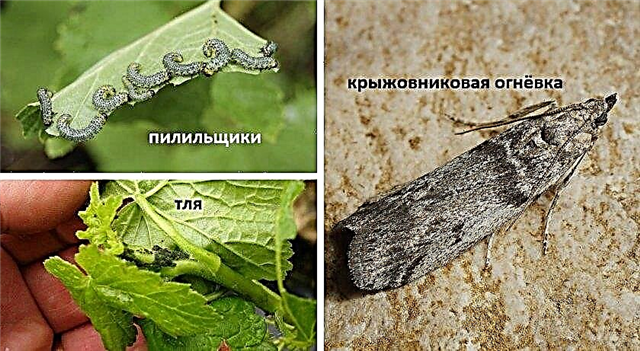
Green rain is a delicious and prolific gooseberry variety. Care procedures do not raise questions, so a beginner in gardening can cope with the cultivation.
Network user reviews
The variety is very productive, but the taste is significantly inferior to Rodnik, but it is tastier than Malachite and I would give more than 4 points.



